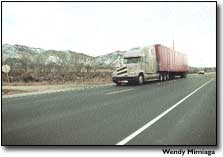|
December 11, 2001
By Tom Vaughan The possibility of a north-south, four-lane highway linking Gallup and Grand Junction through Cortez was raised In a survey of regional trends and issues presented to Leadership Montezuma participants Thursday afternoon. Dave Eppich, director of external affairs at Fort Lewis College, described the ripple effects that highway improvements are causing. U.S. 550, formerly New Mexico 44, is now a four-lane, 70-mph highway from I-25 at Bernalillo to the Colorado state line. The dedication of the newly-improved highway was held Saturday. Even before the improvements on U.S. 550, Eppich pointed out, the Durango-La Plata County airport was experiencing extensive "leakage" — people who drive to Albuquerque in order to have a larger choice of flights and eliminate connecting fares. Now the attraction of flying out of Albuquerque will be even greater. Rio Grande Air has already discontinued its Farmington-Albuquerque flights, Eppich said. Conversely, the shortened driving time between Albuquerque and Southwest Colorado may make New Mexico a more important source for tourism in the Four Corners. Another possible ripple in the transportation pond, according to Eppich, is a proposal to connect the rail stations in Gallup and Grand Junction with a four-lane highway. Such a route would not have to contend with the mountainous terrain that would face a four-lane highway from Durango to Grand Junction and would be a more direct rail-to-rail connection. Eppich did not connect the dots in his discussion, but this development would open the possibility of a fast, east-west link between U.S. 666 and U.S. 550, either through Farmington and Shiprock or Mancos and Cortez. Eppich, one of several local experts to address the Leadership Montezuma class on government and communications issues, also noted that regional water conflicts will play an important part in the future development of the Southwest. Many regional water issues continue to await resolution, Eppich observed, complicated by the fact that past efforts have not adequately addressed current realities. On the one hand, he said, the 1922 compact that apportioned Colorado River water among the states assumed an average in-stream flow of 15 million acre-feet per year. In reality, Eppich reported, the average is about 13 million acre-feet. Not only that, affected Indian nations and the Republic of Mexico were not considered in the compact. New Mexico, rebuffed by El Paso, Texas, in a water-rights dispute, has focused more intensely on water-management planning, Eppich said. This gets close to home for Coloradoans, he observed, when they realize that 65 percent of the water that flows through New Mexico flows through Farmington in the San Juan River. Leadership Montezuma is an annual 10-month program of leadership exploration for citizens, county-wide in scope and headquartered at the Cortez Chamber of Commerce.
|
||
|
Copyright © 2001 the Cortez
Journal. All rights reserved. |
